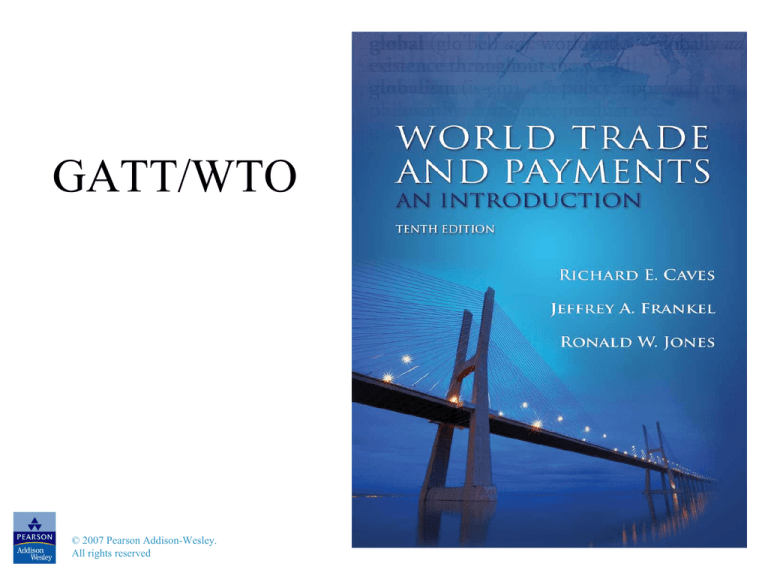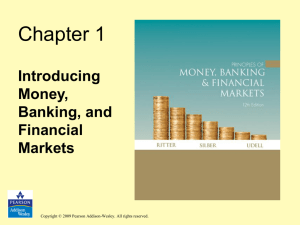
GATT/WTO
© 2007 Pearson Addison-Wesley.
All rights reserved
Which Industries Are Protected?
• Agriculture: in the US, Europe and Japan farmers
make up a small fraction of the electorate but receive
generous subsidies and trade protection.
– Examples: European Union’s Common Agricultural Policy,
Japan’s 1000% tariff on imported rice, America’s sugar
quota.
Copyright © 2007 Pearson Addison-Wesley. All rights reserved.
10-2
Which Industries Are Protected? (cont.)
• Clothing: textiles (fabrication of cloth) and apparel
(assembly of cloth into clothing).
– Import licenses for textile and apparel exporters are
specified in the Multi-Fiber Agreement between the US
and many other nations.
– MFA: U.S. assigned import licenses to exporting countries.
– Hence, most of the welfare cost came not from the
distortion of consumption and production but from the
transfer of quota rents to foreigners.
Copyright © 2007 Pearson Addison-Wesley. All rights reserved.
10-3
Why Agricultural Protection so Notorious?
• Special characters:
– Protection happens in rich countries but not in poor ones.
– It is hard to phase out.
• Economic Rationale
– The inelastic supply of agricultural goods.
– Peasants and the district congressional election
– The minority is easy to form a group to lobby the
government.
– The majority has severe “free-rider” problem.
• Different Patterns:
– Import restriction: Japan, Korea, and China
– Export subsidy: US, CA, EU (supporting price )
Copyright © 2007 Pearson Addison-Wesley. All rights reserved.
10-4
Which Industries Are Protected? (cont.)
Copyright © 2007 Pearson Addison-Wesley. All rights reserved.
10-5
International Negotiations of Trade Policy
• The average US tariff rate on dutiable imports has decreased
substantially from 1920–1993.
• Smoot-Hawley Act deepens the Great Depression.
• Bilateral trade negotiations helped reduce the average duty on
U.S. imports from 59% in 1932 to 25% shortly after WWII.
• Since 1944, much of the reduction in tariffs and other trade
restrictions came about through international negotiations.
– The General Agreement of Tariffs and Trade was begun in 1947 as
a provisional international agreement and was replaced by a more
formal international institution called the World Trade Organization
in 1995.
Copyright © 2007 Pearson Addison-Wesley. All rights reserved.
10-6
International Negotiations
of Trade Policy (cont.)
Copyright © 2007 Pearson Addison-Wesley. All rights reserved.
10-7
International Negotiations
of Trade Policy (cont.)
• Multilateral negotiation mobilizes exporters to
support free trade if they believe export markets will
expand.
– This support would be lacking in a unilateral push for free
trade.
– This support counteracts the support for restricted trade by
import-competing groups.
Copyright © 2007 Pearson Addison-Wesley. All rights reserved.
10-8
International Negotiations
of Trade Policy (cont.)
• Multilateral negotiations also help avoid a trade
war between countries, where each country enacts trade
restrictions.
• If each country has a political interest (due to political
pressure) to protect domestic producers, regardless of what
other countries do,
– then all countries could enact trade restrictions, even if it is in the
interest of all countries to have free trade.
• Let’s use a simple example to illustrate this point.
Copyright © 2007 Pearson Addison-Wesley. All rights reserved.
10-9
International Negotiations
of Trade Policy (cont.)
Copyright © 2007 Pearson Addison-Wesley. All rights reserved.
10-10
International Negotiations
of Trade Policy (cont.)
• In this simple example, each country acting
individually would be better off with protection, but
both would be better off if both chose free trade.
• If Japan and the US can establish a binding agreement
to maintain free trade, both can avoid the temptation
of protection and both can be made better off.
Copyright © 2007 Pearson Addison-Wesley. All rights reserved.
10-11
World Trade Organization
•
The WTO negotiations address trade restrictions in
at least 3 ways:
1. Reduction of tariff rates through multilateral
negotiations.
2. Binding: a tariff is “bound” by having the imposing
country agree not to raise it in the future.
Copyright © 2007 Pearson Addison-Wesley. All rights reserved.
10-12
World Trade Organization (cont.)
3. Prevention of non-tariff barriers: quotas and
export subsidies are changed to tariffs because the
costs of tariff protection are more apparent.
– Subsidies for agricultural exports are an exception.
– Exceptions are also allowed for “market disruptions”
caused by a surge in imports.
Copyright © 2007 Pearson Addison-Wesley. All rights reserved.
10-13
World Trade Organization (cont.)
• The World Trade Organization was founded in 1995
on a number of agreements
– General Agreement on Tariffs and Trade: covers trade in
goods
– General Agreement on Tariffs and Services: covers trade in
services (e.g., insurance, consulting, legal services,
banking).
– Agreement on Trade-Related Aspects of Intellectual
Property: covers international property rights (e.g., patents
and copyrights).
Copyright © 2007 Pearson Addison-Wesley. All rights reserved.
10-14
World Trade Organization (cont.)
– The dispute settlement procedure: a formal procedure
where countries in a trade dispute can bring their case to a
panel of WTO experts to rule upon.
– The cases are settled fairly quickly: even with appeals the
procedure is not supposed to last more than 15 months.
– The panel uses previous agreements by member countries
to decide which ones are breaking their agreements.
Copyright © 2007 Pearson Addison-Wesley. All rights reserved.
10-15
World Trade Organization (cont.)
– A country that refuses to adhere to the panel’s decision
may be punished by allowing other countries to impose
trade restrictions on its exports.
• Example: U.S.—Venezuela
– New U.S. air pollution standard makes the imported
gasoline producers unhappy.
– In 1995, Venezuela argued that the rules violated the
principle of “national treatment”
– The panel appointed by the WTO ruled in Venezuela’s
favor.
– U.S. appealed but rejected, therefore, revised its rules.
Copyright © 2007 Pearson Addison-Wesley. All rights reserved.
10-16
Banana Saga
• Several small central American nations are “banana republics”.
• Historically, UK and France purchased banana from their
previous western Indian colonies in the Caribbean.
• Therefore, to protect benefits of such islands’ producers, the
EU impose import quota for “dollar banana” of Central
America, which are 40% cheaper than the West Indian
product.
• Germany, which has never had West Indian colonies, allowed
free entry to dollar bananas.
• To avoid the arbitrage from Germany to other EU countries,
EU tried to impose a new common European import quota
against dollar bananas.
Copyright © 2007 Pearson Addison-Wesley. All rights reserved.
10-17
Banana Saga
• Germany angrily protested the move and pointed out that its
position is warranted in law in the “banana protocol” of Treaty
of Rome.
• Why so angry? A symbol of freedom.
• In 1995, the U.S. enters the fray by pointing out the quota
harms the interest of the U.S. corporation, The Chiquita
Banana company.
• Its CEO walks both sides of the street to lobby politicians.
• Retaliation from the United States: It imposes high tariffs on
designer handbags and pecorino cheese.
• In 2001, EU phased out the banana import quotas
• In 2005, EU claimed to triple tariff on banana that do not come
from the ACP countries (Africa, Caribbean, and Pacific)
Copyright © 2007 Pearson Addison-Wesley. All rights reserved.
10-18
Various Rounds of GATT/WTO
Copyright © 2007 Pearson Addison-Wesley. All rights reserved.
10-19
Copyright © 2007 Pearson Addison-Wesley. All rights reserved.
10-20
6th Kennedy Rounds of GATT/WTO
• 6th Kennedy Round (completed in 1967):
(1)It reduces tariffs by about 35%
(2)First anti-dumping agreement
(3)Give some exemptions to developing countries
(4)Allow central-planning-economy country as a member.
E.g., Poland becomes a member after 7 years’ application
It imports 7% of its GDP from other countries each year, but
the trade sanction is cancelled by other member countries.
Copyright © 2007 Pearson Addison-Wesley. All rights reserved.
10-21
7th
Tokyo Rounds of GATT/WTO
• 7th Tokyo Round (1973-1979):
(1) It reduces tariffs by a formula more complex than before.
Since 1980, the average tariffs of all commodities reduced
33% within 8 years.
(2) But it doesn’t cover textile, footwear, and steel.
(3) In addition, new codes (9 items) were established in an effort
to control the proliferation of NTBs like anti-dumping, VERs,
government procurement, technical barrier, and so on.
Copyright © 2007 Pearson Addison-Wesley. All rights reserved.
10-22
8th Uruguay Round (1986-1994)
1. Trade liberalization:
• the average tariff imposed by rich countries will fall almost
40%. Tariffs will fall from 6.3% to 3.9%.
• the average tariff imposed by poor countries reduced from
20.5% to 14.4%.
2. Reduce some of the NTBs
3. Signs the GATS—General Agreements on Trade and Services
4. Signs the TRIPs (initial stage)
5. Form the WTO
-- one of the trinity of the world economy.
-- the valid dispute settlement mechanism.
Copyright © 2007 Pearson Addison-Wesley. All rights reserved.
10-23
World Trade Organization (cont.)
• The GATT/WTO multilateral negotiations ratified in
1994
– agreed that all quantitative restrictions (e.g., quotas) on
trade in textiles and clothing as previously specified in the
Multi-Fiber Agreement were to be eliminated by 2005.
– Agricultural subsidies should be reduced by 36% in value,
and 21% in volume over a six-year period.
– But as the restrictions were eliminated (mostly in 2005),
political pressure to again restrict trade in textiles and
clothing has grown.
Copyright © 2007 Pearson Addison-Wesley. All rights reserved.
10-24
WTO
• First Principle: Non-discrimination
• Second principle: Free Trade
• Third principle: Fair trade
• 9th Doha Round (started in 2001): Agriculture,
Services, TRIPS (Trade-Related Aspects of
Intellectual Properties)
Copyright © 2007 Pearson Addison-Wesley. All rights reserved.
10-25
WTO
• Non-discrimination Rule:
(1) Most Favored Nation Treatment (MFN): Each country in
the WTO promises that all countries will pay tariffs no
higher than the nation that pays the lowest.
– An exception to this principle is allowed only if the lowest
tariff rate is set at zero (like the preferential trade
agreements).
– It is unconditional to WTO’s member countries.
– It has to go through the bilateral negotiations between
member country and a non-member country
Copyright © 2007 Pearson Addison-Wesley. All rights reserved.
10-26
MFN: China vs the U.S.
• In 1979, China signed the bilateral MFN agreement with the
U.S.
• According to Jackson-Vanik Amendment, the states had
annual investigation to non-marketing economy like China and
former Soviet Union after 1980.
• Investigation Issues: Immigration policy, human rights,
environment, and weapon
• First challenge in 1990: the U.S. congress agree to terminate
the MFN with China, but President Bush denied it.
• In 1991, Congress passed the proposal to terminate it again
due to the human rights issue, but it was denied again.
Copyright © 2007 Pearson Addison-Wesley. All rights reserved.
10-27
MFN: China vs the U.S.
• In 1993, Clinton changed its initial position to support for
China’s MFN.
• In 1999, whether to pass China’s permanent national trade
relation (PNTR) becomes a hot debate issue.
• Before the vote with the 426 House Representatives:
• Yes– 157
• No—150
• Undecided—119
• Voting results: 237 representatives agree to pass the PNTR.
• China accessed to the WTO in 2001.
Copyright © 2007 Pearson Addison-Wesley. All rights reserved.
10-28
WTO
• Non-discrimination Rule:
(2) National Treatment: “not worse than the domestic firms”
– But could be better.
– True in some developing countries for absorbing FDI.
Copyright © 2007 Pearson Addison-Wesley. All rights reserved.
10-29
Framework
Copyright © 2007 Pearson Addison-Wesley. All rights reserved.
10-30
Copyright © 2007 Pearson Addison-Wesley. All rights reserved.
10-31
Accession
Copyright © 2007 Pearson Addison-Wesley. All rights reserved.
10-32
Preferential Trading Agreements
• Preferential trading agreements are trade agreements between
countries in which they lower tariffs for each other but not for
the rest of the world.
• Under the WTO, such discriminatory trade policies are
generally not allowed:
– Each country in the WTO promises that all countries will pay tariffs no
higher than the nation that pays the lowest: called the “most favored
nation” (MFN) principle.
– An exception to this principle is allowed only if the lowest tariff rate is
set at zero.
Copyright © 2007 Pearson Addison-Wesley. All rights reserved.
10-33
Preferential Trading Agreements (cont.)
•
There are two types of preferential trading
agreements in which tariff rates are set at or near
zero:
1. A free trade area: an agreement that allows free
trade among members, but each member can have
its own trade policy towards non-member countries
–
An example is the North America Free Trade Agreement
(NAFTA).
Copyright © 2007 Pearson Addison-Wesley. All rights reserved.
10-34
Preferential Trading Agreements (cont.)
2. A customs union: an agreement that allows free
trade among members and requires a common
external trade policy towards non-member
countries.
–
An example is the European Union.
Copyright © 2007 Pearson Addison-Wesley. All rights reserved.
10-35
Preferential Trading Agreements (cont.)
• Are preferential trading agreements necessarily good
for national welfare?
• No, it is possible that national welfare decreases
under a preferential trading agreement.
• How? Rather than gaining tariff revenue from
inexpensive imports from world markets, a country
may import expensive products from member
countries but not gain any tariff revenue.
Copyright © 2007 Pearson Addison-Wesley. All rights reserved.
10-36
Preferential Trading Agreements (cont.)
• Preferential trading agreements increase national welfare when
new trade is created, but not when existing trade from the
outside world is diverted to trade with member countries.
• Trade creation
– occurs when high cost domestic production is replaced by low cost
imports from other members.
• Trade diversion
– occurs when low cost imports from non-members are diverted to high
cost imports from member nations.
Copyright © 2007 Pearson Addison-Wesley. All rights reserved.
10-37
Trade Creation
• Three countries: Britain($8)>French($6)>US($4) for wheat
production.
• Suppose British Import tariff =$5.
• Suppose Britain and French forms a customs union.
• British consumer will buy products domestically since 8<9<11
without a customs union
• With a CU, then British consumer will purchase from his
member country—French since 6<8.
• This is trade creation since Britain only needs to pay $6 to
foreign country compared to its own initial cost $8.
Copyright © 2007 Pearson Addison-Wesley. All rights reserved.
10-38
Trade Diversion
• Three country: Britain($8)>French($6)>US($4) for wheat
production.
• Suppose British Import tariff =$3.
• Suppose Britain and French forms a customs union.
• British consumer will buy products from U.S. since 7<8
without a customs union
• With a CU, then British consumer will purchase from his
member country—French since 6<7.
• Trade diversion: (1) US wheat is really cheaper than French;
(2) Import Tariffs revenue disappear.
Copyright © 2007 Pearson Addison-Wesley. All rights reserved.
10-39
Summary
1. The cases for free trade are that
– It allows consumers and producers to allocate their
resources freely and efficiently, without price distortions.
– It may allow for economies of scale.
– It increases competition and innovation.
2. The cases against free trade are that trade restrictions
may allow
– terms of trade gains
– a government to address a market failure when better
policies are not feasible
Copyright © 2007 Pearson Addison-Wesley. All rights reserved.
10-40
Effective Rate of Protection
• The effective rate of protection measures how much
protection a tariff or other trade policy provides domestic
producers.
– It represents the change in value that an industry adds to the production
process when trade policy changes.
– The change in value that an industry provides depends on the change in
prices when trade policies change.
– Effective rates of protection often differ from tariff rates because tariffs
affect sectors other than the protected sector, a fact which affects the
prices and value added for the protected sector.
Copyright © 2007 Pearson Addison-Wesley. All rights reserved.
10-41
Effective Rate of Protection (cont.)
• For example, suppose that an automobile sells on the world
market for $8000, and the parts that made it are worth
$6000.
– The value added of the auto production is
$8000-$6000
• Suppose that a country puts a 25% tariff on imported autos
so that domestic auto assembly firms can now charge up to
$10000 instead of $8000.
• Now auto assembly will occur if the value added is up to
$10000-$6000.
Copyright © 2007 Pearson Addison-Wesley. All rights reserved.
10-42
Effective Rate of Protection (cont.)
• The effective rate of protection for domestic auto
assembly firms is the change in value added:
($4000 - $2000)/$2000 = 100%
• In this case, the effective rate of protection is greater
than the tariff rate.
Copyright © 2007 Pearson Addison-Wesley. All rights reserved.
10-43







